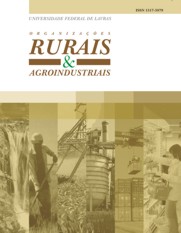Competitiveness of beef exporting slaughterhouses operating in Goiás state: an analysis from the perspective of the firm
Keywords:
Competitiveness, exporting slaughterhouses, Goiás stateAbstract
Due to the importance of the beef chain to the economy of Goiás state and the topic relevance, we an alyzed in a comparative way the competitiveness of exporting slaughterhouses installed in the State of Goiás. Firm A emerged in 1957 in Barretos (SP). It has two slaughterhouse units operating in the State of Goiás, being one in the municipalities of Palmeiras with slaughter capacity of 2,000 head/day, and one in Goianésia with capacity of 500 head/day. The Firm B started its activities in 1953 in the city of Anapolis (GO). Firm B has three plants operating in Goiás state, located in the cities of Goiânia, Anápolis and Mozarlândia, with slaughter capacity of 2,000, 500, and 2,000 heads/day, respectively. Competitive analysis was developed through competitive drivers and subfactors, using Likert scale, ranging from “very favorable” (+2) to “very unfavorable” (-2), totaling seven drivers and 55 subfactors, which were evaluated from exporting slaughterhouse perspective. It was found that the slaughterhouses, even located in the same geographical zone, have different characteristics regarding the physical and economic structure, management, market share, size of transactions, types of distribution channels, structure of distribution in foreign markets, types of transport, slaughter methods, among others. Despite these differences, the marks awarded to the drivers by the representatives of both firms followed the same trend. The weighted average of drivers of competitiveness for Firm A was 1.0 and for Firm B 1.02. It can be considered that from the point of view of the representatives of exporting slaughterhouses, the analyzed drivers contribute positively to the competitiveness of the beef exporting industry.


